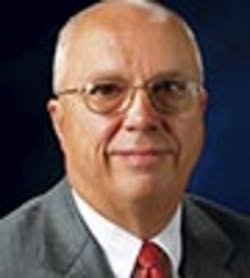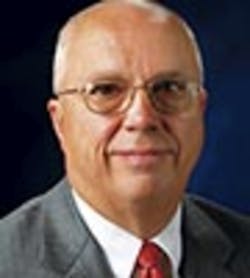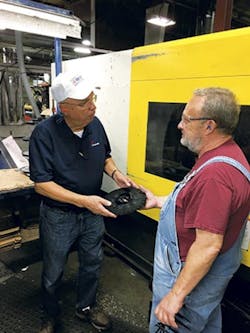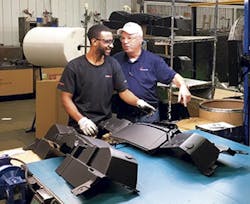Success through balance
For Bob Janeczko, who started out in metals but bought a plastics business in 2003 with his son, success is all about values and balance. From balancing new technology with trusted machines to applying core values when weighing the needs of all the company's stakeholders, i2-tech's 14-year path to a multimillion-dollar business bears out the company strategy.
Janeczko discussed his career with PMM correspondent Lisa Jo Lupo.
Just the facts
WHO IS HE: Bob Janeczko, chairman of Innovative Injection Technologies Inc. (i2-tech)HEADQUARTERS: West Des Moines, IowaFOUNDED: 2003EMPLOYEES: 170FAMILY MATTERS: In 2014, Bob Janeczko sold his shares in the company to his son, Josh.
With a background in metals, how did you get into plastics?Janeczko: I was retiring from the metals division of Morton Industrial Group when one of its plastics units, Mid-Central Plastics, was for sale. So, I bought it in 2003 in a leveraged buyout as a kind of retirement package with my son, Josh. We wanted to go into manufacturing, and this just happened to be in plastics, so I was still really green to the plastics industry, though not in manufacturing.In 2014, you sold your shares of i2-tech to your son, Josh, making him sole owner. Why?Janeczko: That was the intention from the beginning. He was my partner in '03. He was about 26, and I wanted everybody to know that eventually they'd be working for him and not for me. But I sold it to him — I didn't give it to him.
You've never been afraid of investing in the latest equipment. Why is this important?Janeczko: It's really about productivity. When we bought the company, the equipment was probably 10 to 15 years old. We knew from being in manufacturing that you can't stay alive efficiently, productively and costwise with old equipment.But we also know the value of equipment. In the late 1960s, Mid-Central Plastics had bought the very first Milacron injection molding machine; we ran the machine for 40 years through three company changes — Mid-Central, then Morton Custom Plastic, then i2-tech. We finally sold it a few years ago back to Milacron. I kept it all those years to demonstrate our competency in maintenance, that we could keep things rolling if we had to, and Milacron was willing to support it.
In 2013, i2-tech invested in a Milacron Maxima G Servo 3,300-ton, making it the only molder in Iowa with two machines over 3,000 tons. Has the company added other large machines?Janeczko: The [3,300-ton unit] is the highest we have, but we have added a 2,600-ton. We have a unique market niche in that we will do large-tonnage, low-volume, highly cosmetic, highly engineered parts. We average 13 tool changes a day in a 24-hour cycle; some of those tools weigh up to 70,000 pounds. So, we're talking changing out some very large pieces of equipment every two hours. Many people have chosen a model where they put a tool on a machine and run it the rest of its life; they never take it out. We have chosen a more difficult market. We have color changes — the machine has to be purged after material changes — there is a lot of set-up time involved, so we have to be very, very efficient. And it's expensive: Large-tonnage machines demand very, very expensive infrastructure support.
What does i2-tech use its 3-D printer for? What is the future for 3-D printing?Janeczko: About two or three years ago, we purchased a Stratasys Fortus 450mc 3-D production printer that primarily helps us in prototyping. It also helps us in a quality area — in gauges and fixtures to measure and qualify parts. It's a very low-cost alternative for gauging and measuring quickly.Someday, some way, 3-D [printing] may yield production parts if you have low volume, but as a manufacturer, you have to decide if that's what you want to do. It's a little like people buying their first electric machine and saying, "I got one, I'm in." We like technology, but we also have to have the reliability. We run 24/7, so we have to have service around the clock, and it has to be serviced by our people internally.But, anything is possible! You never want to say never, because it's very possible — they are getting larger. It's also a little like electric injection molding machines. When they came out, they were quite small and now they're getting up to the higher-tonnage machines — people just kept testing and progressing. I think that's also very possible with 3-D additive manufacturing. It's an entrepreneurial technology; it's wide open, and I wouldn't bet against American entrepreneurs.
You are adamant about safety, telling employees, "There is nothing in that shop — not a part, a customer or a machine — that is worth getting hurt over." What are your safety criteria in the shop and for machinery?Janeczko: We're a privately held company, a family business, and I want my shop to be as safe as it possibly can be. Safety is a win-win situation. The employee certainly doesn't want to be hurt, and we don't want to inflict any kind of pain on the employee or his or her family. Secondly, it's a win for us because the employee is available and ready to perform at a high level because he or she believes they are working in a safe environment. Because you don't have accidents, you have a readily available workforce. There's all kinds of negatives with accidents. People who don't see that ahead of time, who aren't proactive and trying to do root cause, not only cause human suffering, but also take employees and machines out of production. There's a certain amount of trust between customers and equipment manufacturers that they have gone through their safety steps, evaluated the equipment, and tried to generate circumstances that can't be overridden. I don't believe we have any weak spots in the equipment industry in the United States. From an industry standpoint, we don't see machines unguarded; we are a mature industry. We don't have any false movements, any uncontrolled operations — they are very repeatable, reliable pieces of equipment.Equipment training is also well-supported by the manufacturers; they come in and demonstrate the technologies to us. But, one of my pet peeves is that there is more technology in that machine than we choose to use. Industrywide, demands of production sometimes overshadow technology curiosity. Our people will try features that an equipment manufacturer stresses, but maybe in our molding operation, the feature is not as great as the salesman believes it is. We try it and say, "Not for us; we don't think we need that technology." Smart phones are a very good analogy: Your life overshadows your time and ability to go deep into the phone; your life in production is just as demanding.
You have been very involved with the Plastics Industry Association. What is your role and why is participation important to you?Janeczko: I bought our company on Friday, June 20, 2003, then was at the opening of the NPE show on Monday, June 23, so I went right from the closing to my first NPE. I saw that the entire industry is in one location every three years, so my purpose of joining was to build my brand; to know all the equipment manufacturers, all the robotics people, all the materials and tooling people. That's how I got to meet the industry leaders very quickly, by actively getting involved. I'm now on the board of directors; I am chairman of the association's Political Action Committee (PAC) for lobbying and advocacy with local, state and federal governments; and I'm on the NPE Executive Committee because I'm chairman of the NPE Attendee Experience Committee, which has a goal of attracting nontraditional attendees to the NPE.
What do you see as your legacy in the plastics industry? How would you like to be remembered?Janeczko: Our business has identified five stakeholder groups: customer, employee, shareholder, supplier, and community. They are constantly demanding your time, and there isn't a day that goes by that the groups' wants are in alignment. But if you neglect any of those five groups, you will have problems in your business. So, our job is to balance those relationships. How do you do that?Our core values are responsiveness, innovation, trust, credibility, respect, fairness, pride, camaraderie. We look for people who demonstrate those values and we train on them; we work very, very hard to have our people understand our core values, and practice them to balance the issues that happen during the day. That's the legacy that I think holds up. I want to be known as the business that used a good value system to run our business and tried as best we could to keep all five segments happy.




